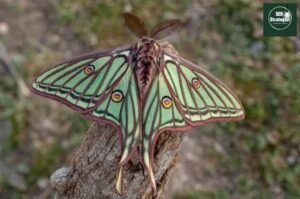21
Luna Moth Article by Sadiq Amin:
The Luna Moth (Actias luna) is a strikingly beautiful moth native to North America. It is part of the Saturniidae family, one of the largest families of moths. Here are some key details about the Luna Moth:
Physical Characteristics:
- Wingspan: Luna moths have a large wingspan, typically between 3 to 4.5 inches (7.6 to 11.4 cm).
- Coloration: Luna moth are known for their pale green wings, which is one of their most distinctive features. The wings have iridescent tones that shimmer in the light.
- Tail-like extensions: The hindwings have long, elegant tails, adding to their delicate and graceful appearance.
- Eyespots: On the wings, there are two large, circular eyespots—one on each hindwing. These are thought to be a defense mechanism to confuse predators by mimicking the eyes of a larger animal.
- Body: The body of the luna moth is furry and light green. It is relatively robust in comparison to its wings.

luna-moth
Life Cycle:
- Eggs: The Luna moth lays its eggs on the leaves of trees such as walnut, hickory, birch, and sumac.
- Caterpillar (Larva): The larvae of luna moth are large and green, with small spines. They feed on the leaves of trees and can grow quite large.
- Pupa (Cocoon): The caterpillar of luna moth eventually transforms into a pupa, which is encased in a brown, papery cocoon made from silk. The pupa overwinter in the soil or leaf litter.
- Adult Moth: After metamorphosis, the adult moth emerges, usually in the late spring or early summer. Adult Luna moths do not eat. Their primary goal is reproduction, as they only live for about a week.
- If you want to experience visual life cycle ave a look on video.
Behavior:
- Nocturnal: Luna moths are nocturnal, meaning they are active at night. Their large, sensitive antennae help them locate potential mates through the detection of pheromones.
- Short lifespan: As adults, Luna moths only live for about 7 days, during which time they do not feed. Their primary function is to mate and lay eggs.
Habitat:
- Geographic Range: Luna moths are found across much of North America, particularly in the eastern U.S. and parts of Canada. They prefer forested areas with a variety of trees for feeding and laying eggs.
- Environment: luna moth are often spotted near woods, gardens, and parks, especially during the summer months.

luna-moth
Predators:
- Despite their beauty, Luna moths are not immune to predators. Birds, such as crows and blue jays, are common predators, attracted by the moth’s size and color. The eyespots on the wings of luna moth are believed to deter these predators, as they may mimic the eyes of larger animals, potentially intimidating the birds.
Significance:
- Cultural: The Luna moth is often regarded as a symbol of transformation due to its dramatic metamorphosis from caterpillar to moth.
- Ecological: As part of the food web, Luna moths are important in maintaining ecological balance by serving as prey for various animals.
The Luna moth’s striking appearance and intriguing life cycle have made it a subject of admiration and interest among entomologists and nature lovers alike.
have you ever meet Arabian horse. If not visit site for meetup.